An Analysis of Health Promotion Strategies for Diabetes Mellitus
VerifiedAdded on 2023/03/17
|8
|2298
|26
Essay
AI Summary
This essay delves into health promotion strategies for diabetes mellitus, emphasizing the application of the Ottawa Charter's five key strategies. It begins by highlighting the importance of health promotion in managing diabetes and improving individual well-being. The essay then explores each strategy, including building public health policy through legislation and funding, creating supportive environments by ensuring safe and satisfying healthcare settings, strengthening community action by empowering community nurses, developing personal skills through patient education and self-management, and reorienting health services to prioritize health promotion. The role of midwives in implementing these strategies is discussed, with examples from Australia's healthcare system. The essay underscores the need for collaborative efforts among healthcare professionals to effectively manage diabetes and promote community health.
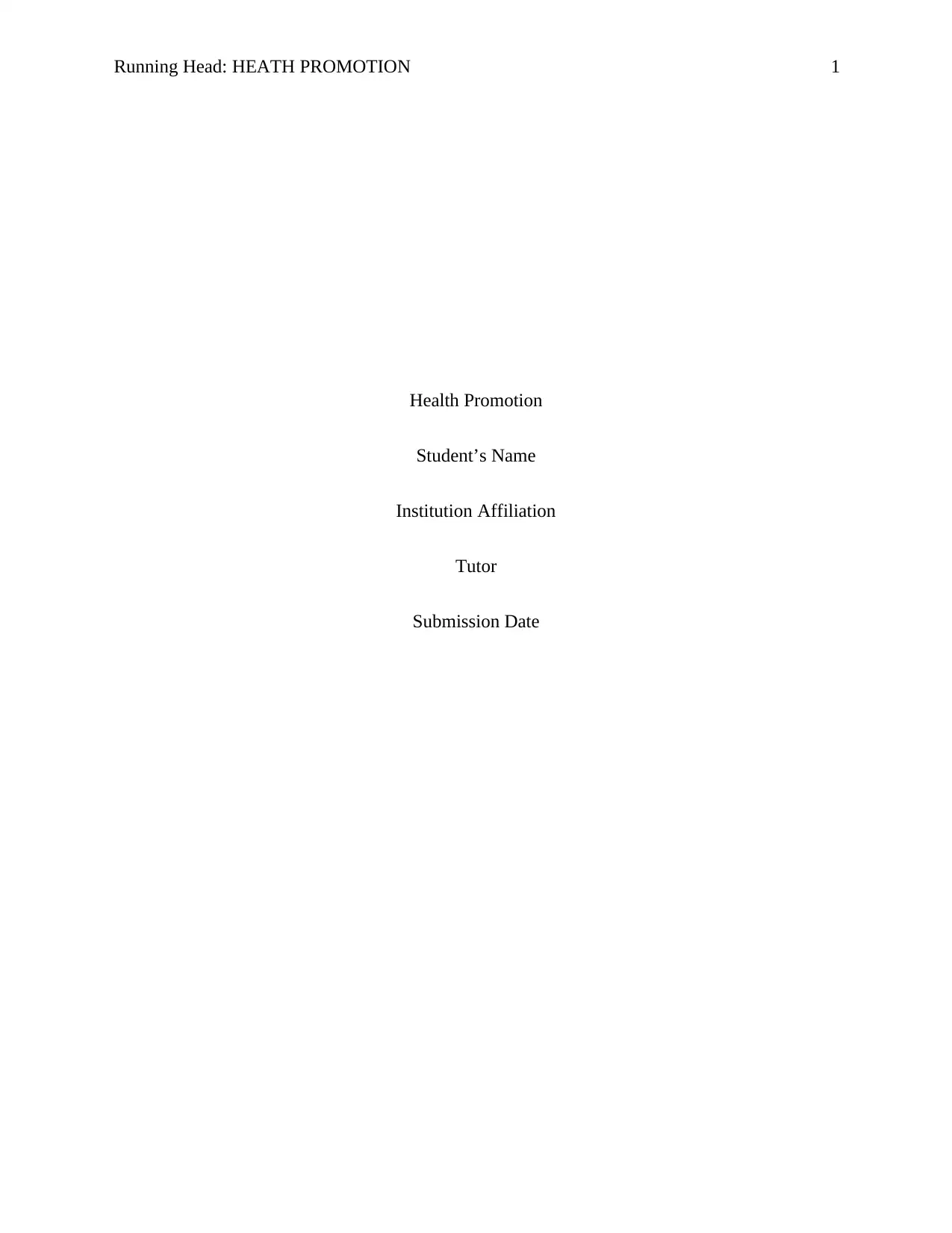
Running Head: HEATH PROMOTION 1
Health Promotion
Student’s Name
Institution Affiliation
Tutor
Submission Date
Health Promotion
Student’s Name
Institution Affiliation
Tutor
Submission Date
Paraphrase This Document
Need a fresh take? Get an instant paraphrase of this document with our AI Paraphraser
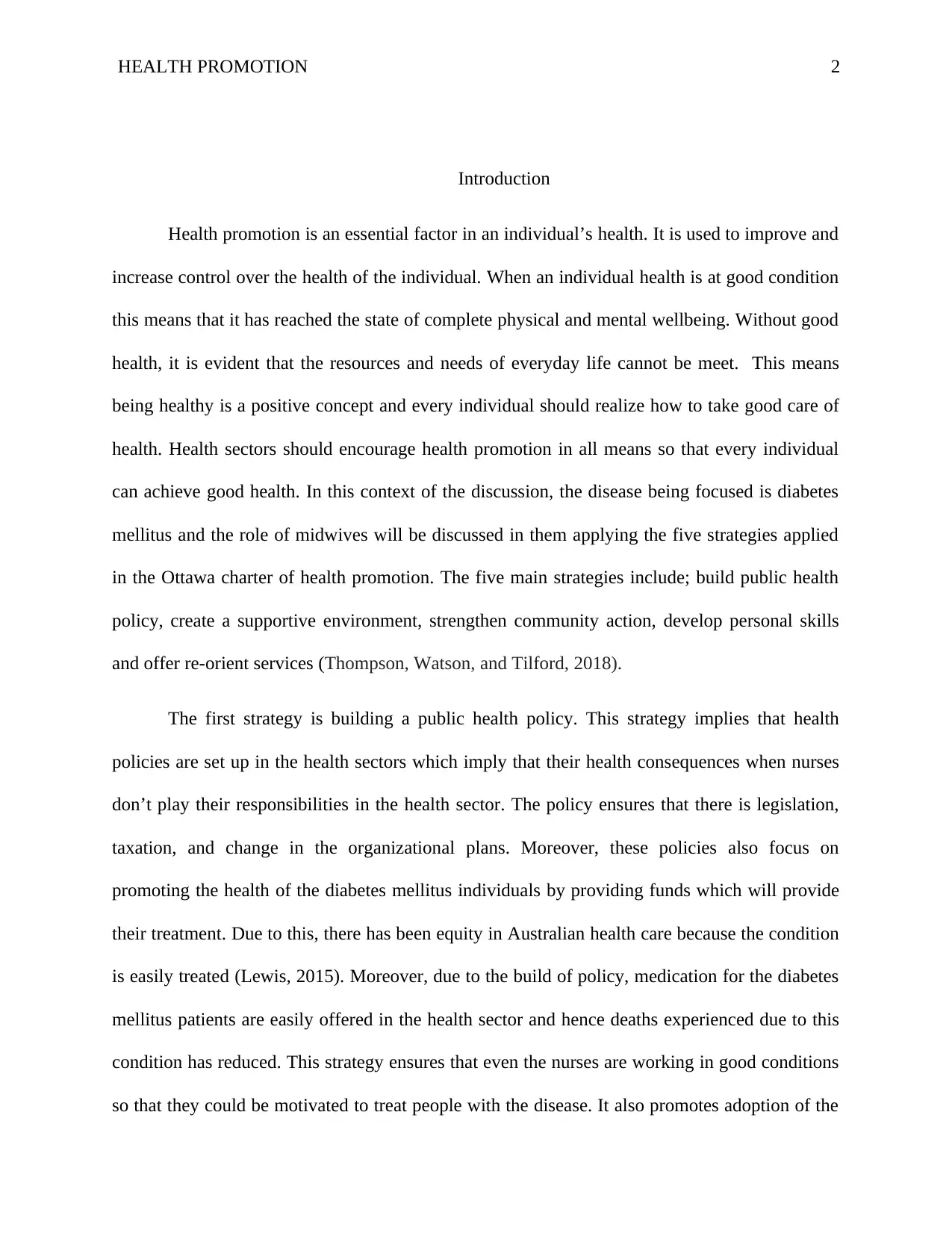
HEALTH PROMOTION 2
Introduction
Health promotion is an essential factor in an individual’s health. It is used to improve and
increase control over the health of the individual. When an individual health is at good condition
this means that it has reached the state of complete physical and mental wellbeing. Without good
health, it is evident that the resources and needs of everyday life cannot be meet. This means
being healthy is a positive concept and every individual should realize how to take good care of
health. Health sectors should encourage health promotion in all means so that every individual
can achieve good health. In this context of the discussion, the disease being focused is diabetes
mellitus and the role of midwives will be discussed in them applying the five strategies applied
in the Ottawa charter of health promotion. The five main strategies include; build public health
policy, create a supportive environment, strengthen community action, develop personal skills
and offer re-orient services (Thompson, Watson, and Tilford, 2018).
The first strategy is building a public health policy. This strategy implies that health
policies are set up in the health sectors which imply that their health consequences when nurses
don’t play their responsibilities in the health sector. The policy ensures that there is legislation,
taxation, and change in the organizational plans. Moreover, these policies also focus on
promoting the health of the diabetes mellitus individuals by providing funds which will provide
their treatment. Due to this, there has been equity in Australian health care because the condition
is easily treated (Lewis, 2015). Moreover, due to the build of policy, medication for the diabetes
mellitus patients are easily offered in the health sector and hence deaths experienced due to this
condition has reduced. This strategy ensures that even the nurses are working in good conditions
so that they could be motivated to treat people with the disease. It also promotes adoption of the
Introduction
Health promotion is an essential factor in an individual’s health. It is used to improve and
increase control over the health of the individual. When an individual health is at good condition
this means that it has reached the state of complete physical and mental wellbeing. Without good
health, it is evident that the resources and needs of everyday life cannot be meet. This means
being healthy is a positive concept and every individual should realize how to take good care of
health. Health sectors should encourage health promotion in all means so that every individual
can achieve good health. In this context of the discussion, the disease being focused is diabetes
mellitus and the role of midwives will be discussed in them applying the five strategies applied
in the Ottawa charter of health promotion. The five main strategies include; build public health
policy, create a supportive environment, strengthen community action, develop personal skills
and offer re-orient services (Thompson, Watson, and Tilford, 2018).
The first strategy is building a public health policy. This strategy implies that health
policies are set up in the health sectors which imply that their health consequences when nurses
don’t play their responsibilities in the health sector. The policy ensures that there is legislation,
taxation, and change in the organizational plans. Moreover, these policies also focus on
promoting the health of the diabetes mellitus individuals by providing funds which will provide
their treatment. Due to this, there has been equity in Australian health care because the condition
is easily treated (Lewis, 2015). Moreover, due to the build of policy, medication for the diabetes
mellitus patients are easily offered in the health sector and hence deaths experienced due to this
condition has reduced. This strategy ensures that even the nurses are working in good conditions
so that they could be motivated to treat people with the disease. It also promotes adoption of the
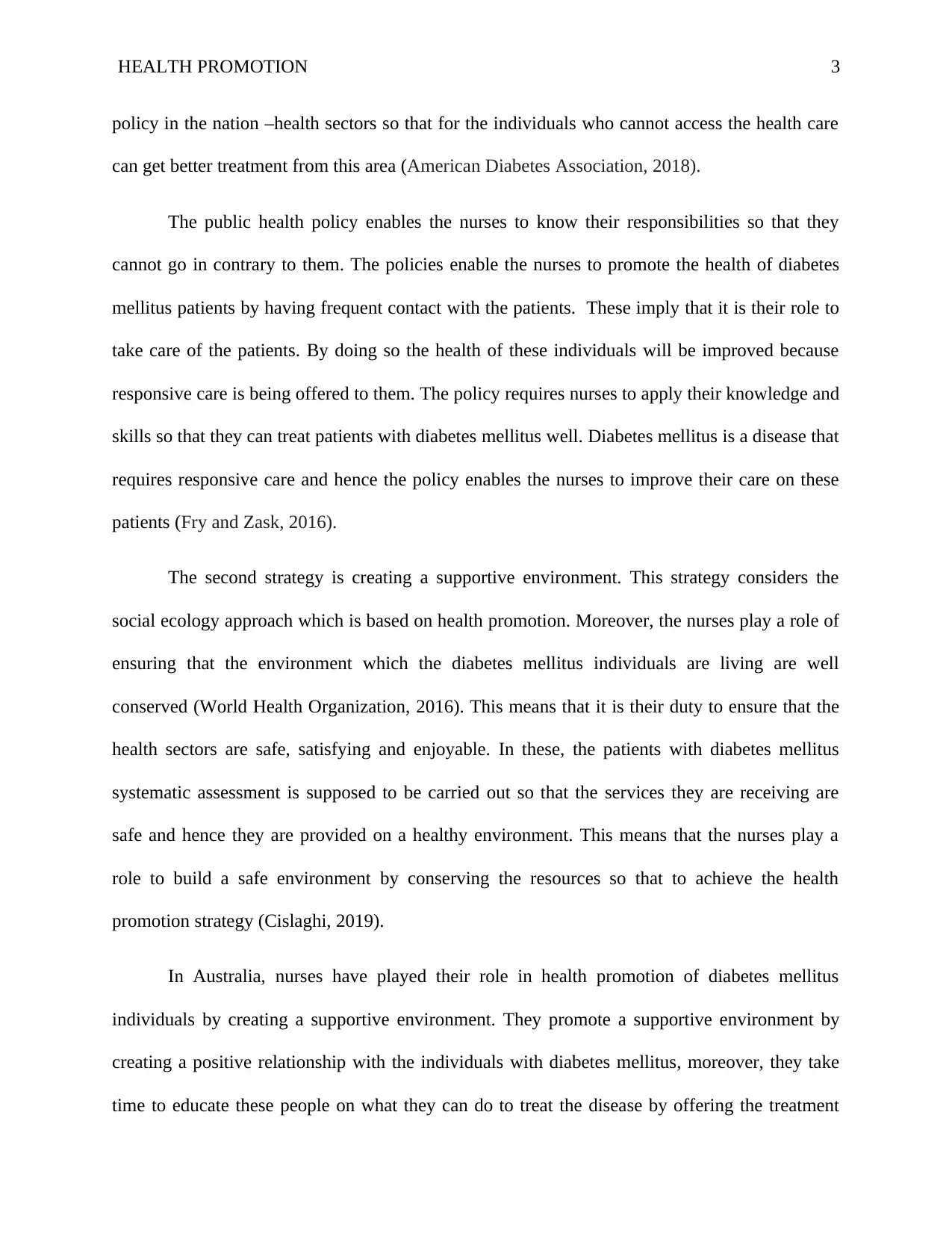
HEALTH PROMOTION 3
policy in the nation –health sectors so that for the individuals who cannot access the health care
can get better treatment from this area (American Diabetes Association, 2018).
The public health policy enables the nurses to know their responsibilities so that they
cannot go in contrary to them. The policies enable the nurses to promote the health of diabetes
mellitus patients by having frequent contact with the patients. These imply that it is their role to
take care of the patients. By doing so the health of these individuals will be improved because
responsive care is being offered to them. The policy requires nurses to apply their knowledge and
skills so that they can treat patients with diabetes mellitus well. Diabetes mellitus is a disease that
requires responsive care and hence the policy enables the nurses to improve their care on these
patients (Fry and Zask, 2016).
The second strategy is creating a supportive environment. This strategy considers the
social ecology approach which is based on health promotion. Moreover, the nurses play a role of
ensuring that the environment which the diabetes mellitus individuals are living are well
conserved (World Health Organization, 2016). This means that it is their duty to ensure that the
health sectors are safe, satisfying and enjoyable. In these, the patients with diabetes mellitus
systematic assessment is supposed to be carried out so that the services they are receiving are
safe and hence they are provided on a healthy environment. This means that the nurses play a
role to build a safe environment by conserving the resources so that to achieve the health
promotion strategy (Cislaghi, 2019).
In Australia, nurses have played their role in health promotion of diabetes mellitus
individuals by creating a supportive environment. They promote a supportive environment by
creating a positive relationship with the individuals with diabetes mellitus, moreover, they take
time to educate these people on what they can do to treat the disease by offering the treatment
policy in the nation –health sectors so that for the individuals who cannot access the health care
can get better treatment from this area (American Diabetes Association, 2018).
The public health policy enables the nurses to know their responsibilities so that they
cannot go in contrary to them. The policies enable the nurses to promote the health of diabetes
mellitus patients by having frequent contact with the patients. These imply that it is their role to
take care of the patients. By doing so the health of these individuals will be improved because
responsive care is being offered to them. The policy requires nurses to apply their knowledge and
skills so that they can treat patients with diabetes mellitus well. Diabetes mellitus is a disease that
requires responsive care and hence the policy enables the nurses to improve their care on these
patients (Fry and Zask, 2016).
The second strategy is creating a supportive environment. This strategy considers the
social ecology approach which is based on health promotion. Moreover, the nurses play a role of
ensuring that the environment which the diabetes mellitus individuals are living are well
conserved (World Health Organization, 2016). This means that it is their duty to ensure that the
health sectors are safe, satisfying and enjoyable. In these, the patients with diabetes mellitus
systematic assessment is supposed to be carried out so that the services they are receiving are
safe and hence they are provided on a healthy environment. This means that the nurses play a
role to build a safe environment by conserving the resources so that to achieve the health
promotion strategy (Cislaghi, 2019).
In Australia, nurses have played their role in health promotion of diabetes mellitus
individuals by creating a supportive environment. They promote a supportive environment by
creating a positive relationship with the individuals with diabetes mellitus, moreover, they take
time to educate these people on what they can do to treat the disease by offering the treatment
⊘ This is a preview!⊘
Do you want full access?
Subscribe today to unlock all pages.

Trusted by 1+ million students worldwide
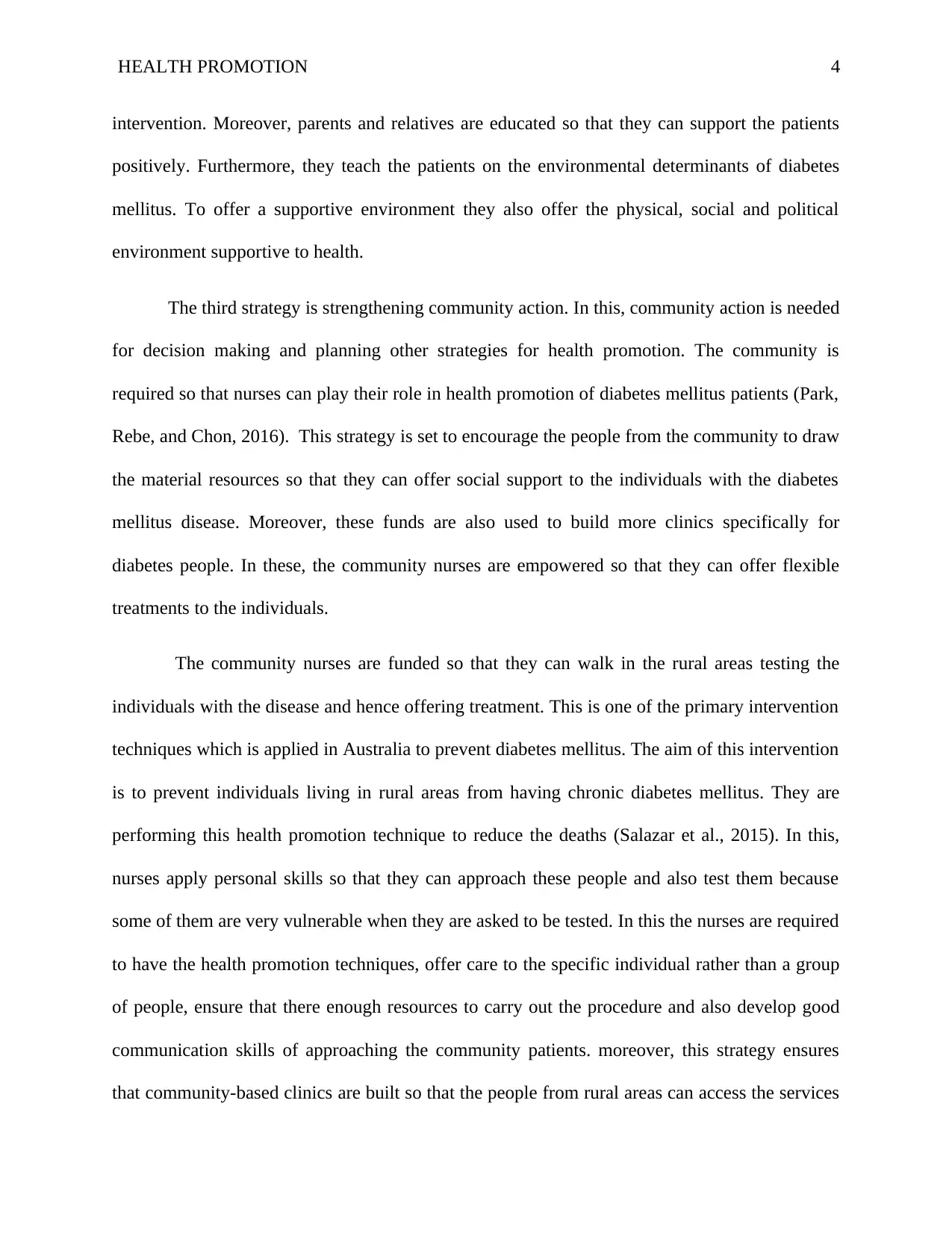
HEALTH PROMOTION 4
intervention. Moreover, parents and relatives are educated so that they can support the patients
positively. Furthermore, they teach the patients on the environmental determinants of diabetes
mellitus. To offer a supportive environment they also offer the physical, social and political
environment supportive to health.
The third strategy is strengthening community action. In this, community action is needed
for decision making and planning other strategies for health promotion. The community is
required so that nurses can play their role in health promotion of diabetes mellitus patients (Park,
Rebe, and Chon, 2016). This strategy is set to encourage the people from the community to draw
the material resources so that they can offer social support to the individuals with the diabetes
mellitus disease. Moreover, these funds are also used to build more clinics specifically for
diabetes people. In these, the community nurses are empowered so that they can offer flexible
treatments to the individuals.
The community nurses are funded so that they can walk in the rural areas testing the
individuals with the disease and hence offering treatment. This is one of the primary intervention
techniques which is applied in Australia to prevent diabetes mellitus. The aim of this intervention
is to prevent individuals living in rural areas from having chronic diabetes mellitus. They are
performing this health promotion technique to reduce the deaths (Salazar et al., 2015). In this,
nurses apply personal skills so that they can approach these people and also test them because
some of them are very vulnerable when they are asked to be tested. In this the nurses are required
to have the health promotion techniques, offer care to the specific individual rather than a group
of people, ensure that there enough resources to carry out the procedure and also develop good
communication skills of approaching the community patients. moreover, this strategy ensures
that community-based clinics are built so that the people from rural areas can access the services
intervention. Moreover, parents and relatives are educated so that they can support the patients
positively. Furthermore, they teach the patients on the environmental determinants of diabetes
mellitus. To offer a supportive environment they also offer the physical, social and political
environment supportive to health.
The third strategy is strengthening community action. In this, community action is needed
for decision making and planning other strategies for health promotion. The community is
required so that nurses can play their role in health promotion of diabetes mellitus patients (Park,
Rebe, and Chon, 2016). This strategy is set to encourage the people from the community to draw
the material resources so that they can offer social support to the individuals with the diabetes
mellitus disease. Moreover, these funds are also used to build more clinics specifically for
diabetes people. In these, the community nurses are empowered so that they can offer flexible
treatments to the individuals.
The community nurses are funded so that they can walk in the rural areas testing the
individuals with the disease and hence offering treatment. This is one of the primary intervention
techniques which is applied in Australia to prevent diabetes mellitus. The aim of this intervention
is to prevent individuals living in rural areas from having chronic diabetes mellitus. They are
performing this health promotion technique to reduce the deaths (Salazar et al., 2015). In this,
nurses apply personal skills so that they can approach these people and also test them because
some of them are very vulnerable when they are asked to be tested. In this the nurses are required
to have the health promotion techniques, offer care to the specific individual rather than a group
of people, ensure that there enough resources to carry out the procedure and also develop good
communication skills of approaching the community patients. moreover, this strategy ensures
that community-based clinics are built so that the people from rural areas can access the services
Paraphrase This Document
Need a fresh take? Get an instant paraphrase of this document with our AI Paraphraser
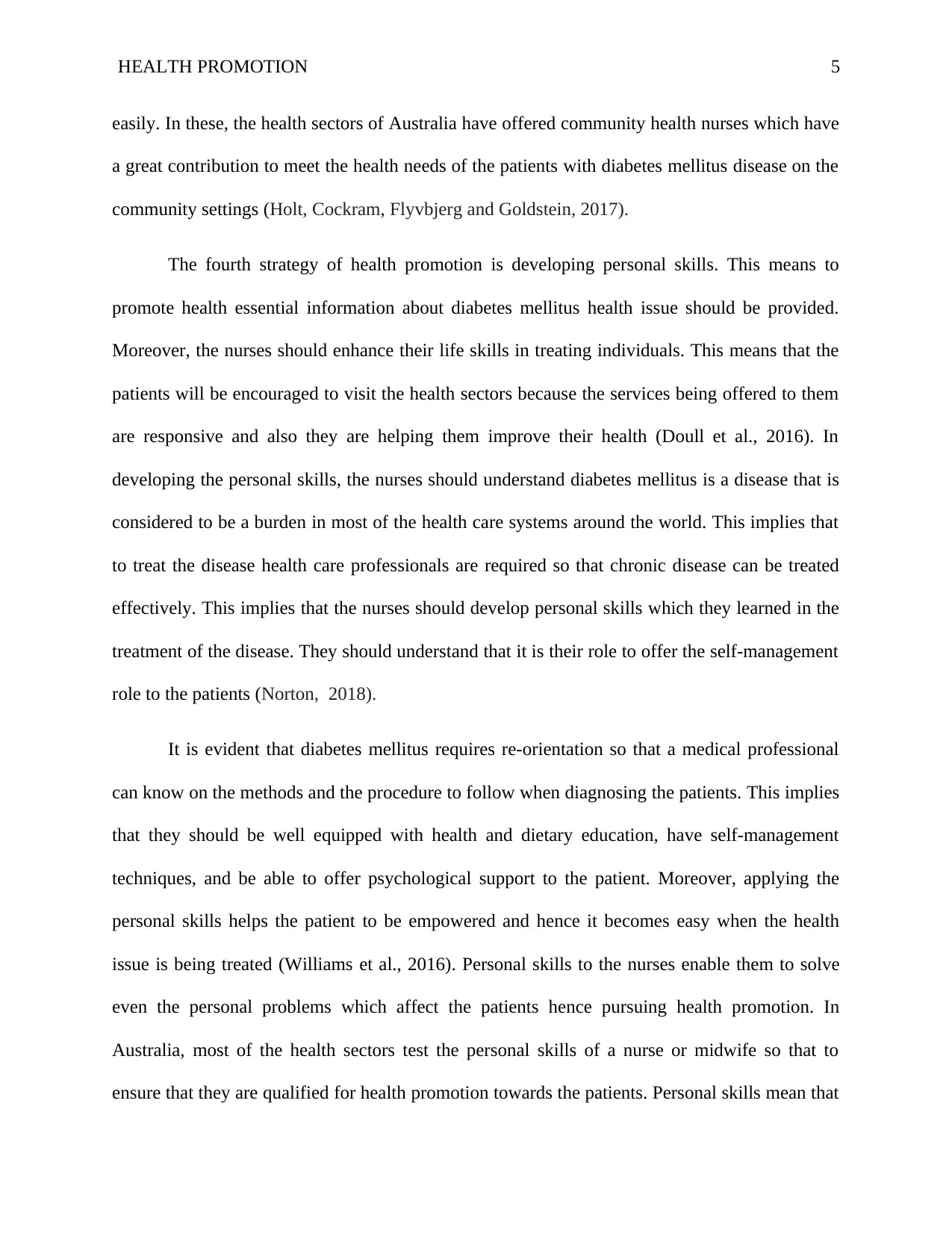
HEALTH PROMOTION 5
easily. In these, the health sectors of Australia have offered community health nurses which have
a great contribution to meet the health needs of the patients with diabetes mellitus disease on the
community settings (Holt, Cockram, Flyvbjerg and Goldstein, 2017).
The fourth strategy of health promotion is developing personal skills. This means to
promote health essential information about diabetes mellitus health issue should be provided.
Moreover, the nurses should enhance their life skills in treating individuals. This means that the
patients will be encouraged to visit the health sectors because the services being offered to them
are responsive and also they are helping them improve their health (Doull et al., 2016). In
developing the personal skills, the nurses should understand diabetes mellitus is a disease that is
considered to be a burden in most of the health care systems around the world. This implies that
to treat the disease health care professionals are required so that chronic disease can be treated
effectively. This implies that the nurses should develop personal skills which they learned in the
treatment of the disease. They should understand that it is their role to offer the self-management
role to the patients (Norton, 2018).
It is evident that diabetes mellitus requires re-orientation so that a medical professional
can know on the methods and the procedure to follow when diagnosing the patients. This implies
that they should be well equipped with health and dietary education, have self-management
techniques, and be able to offer psychological support to the patient. Moreover, applying the
personal skills helps the patient to be empowered and hence it becomes easy when the health
issue is being treated (Williams et al., 2016). Personal skills to the nurses enable them to solve
even the personal problems which affect the patients hence pursuing health promotion. In
Australia, most of the health sectors test the personal skills of a nurse or midwife so that to
ensure that they are qualified for health promotion towards the patients. Personal skills mean that
easily. In these, the health sectors of Australia have offered community health nurses which have
a great contribution to meet the health needs of the patients with diabetes mellitus disease on the
community settings (Holt, Cockram, Flyvbjerg and Goldstein, 2017).
The fourth strategy of health promotion is developing personal skills. This means to
promote health essential information about diabetes mellitus health issue should be provided.
Moreover, the nurses should enhance their life skills in treating individuals. This means that the
patients will be encouraged to visit the health sectors because the services being offered to them
are responsive and also they are helping them improve their health (Doull et al., 2016). In
developing the personal skills, the nurses should understand diabetes mellitus is a disease that is
considered to be a burden in most of the health care systems around the world. This implies that
to treat the disease health care professionals are required so that chronic disease can be treated
effectively. This implies that the nurses should develop personal skills which they learned in the
treatment of the disease. They should understand that it is their role to offer the self-management
role to the patients (Norton, 2018).
It is evident that diabetes mellitus requires re-orientation so that a medical professional
can know on the methods and the procedure to follow when diagnosing the patients. This implies
that they should be well equipped with health and dietary education, have self-management
techniques, and be able to offer psychological support to the patient. Moreover, applying the
personal skills helps the patient to be empowered and hence it becomes easy when the health
issue is being treated (Williams et al., 2016). Personal skills to the nurses enable them to solve
even the personal problems which affect the patients hence pursuing health promotion. In
Australia, most of the health sectors test the personal skills of a nurse or midwife so that to
ensure that they are qualified for health promotion towards the patients. Personal skills mean that
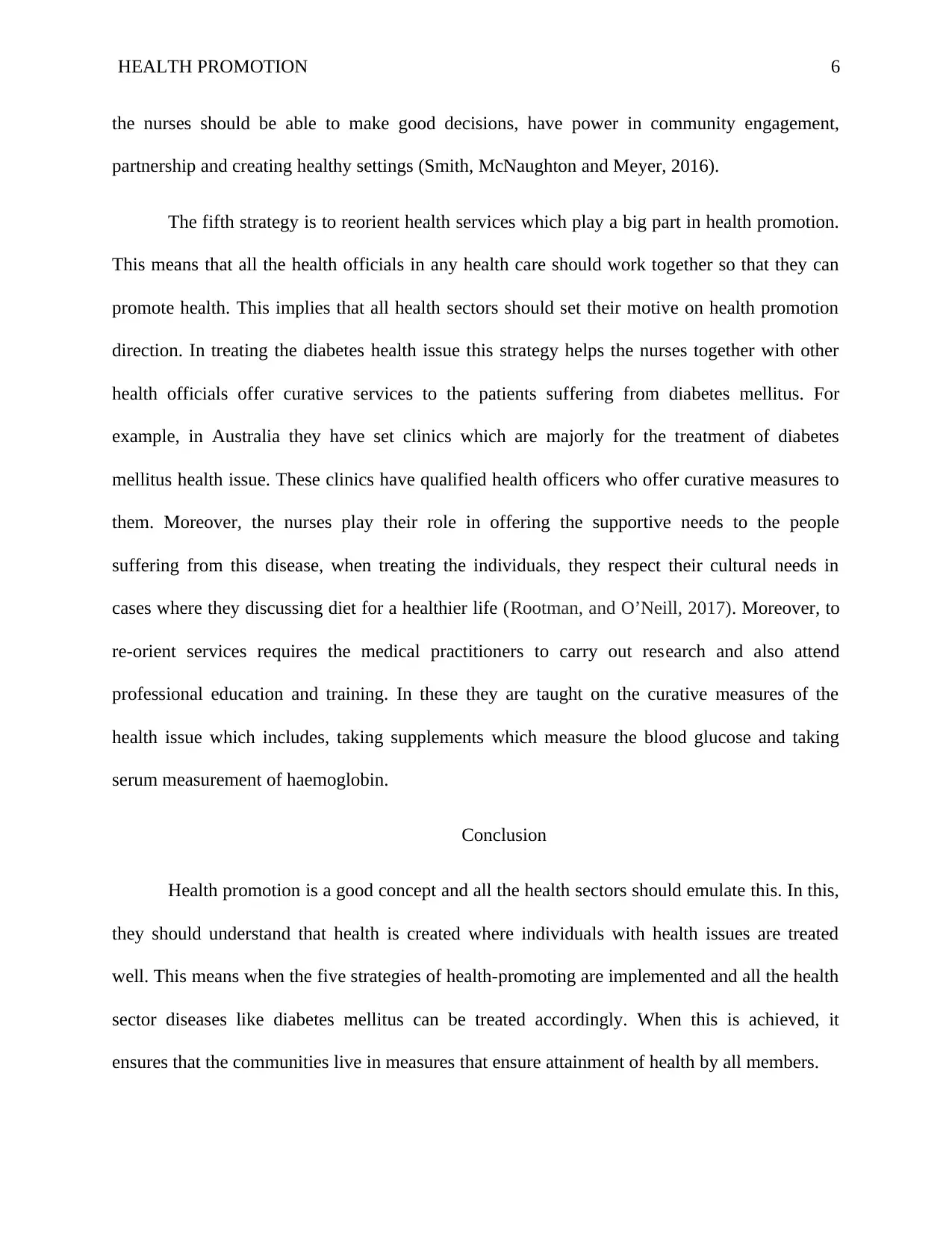
HEALTH PROMOTION 6
the nurses should be able to make good decisions, have power in community engagement,
partnership and creating healthy settings (Smith, McNaughton and Meyer, 2016).
The fifth strategy is to reorient health services which play a big part in health promotion.
This means that all the health officials in any health care should work together so that they can
promote health. This implies that all health sectors should set their motive on health promotion
direction. In treating the diabetes health issue this strategy helps the nurses together with other
health officials offer curative services to the patients suffering from diabetes mellitus. For
example, in Australia they have set clinics which are majorly for the treatment of diabetes
mellitus health issue. These clinics have qualified health officers who offer curative measures to
them. Moreover, the nurses play their role in offering the supportive needs to the people
suffering from this disease, when treating the individuals, they respect their cultural needs in
cases where they discussing diet for a healthier life (Rootman, and O’Neill, 2017). Moreover, to
re-orient services requires the medical practitioners to carry out research and also attend
professional education and training. In these they are taught on the curative measures of the
health issue which includes, taking supplements which measure the blood glucose and taking
serum measurement of haemoglobin.
Conclusion
Health promotion is a good concept and all the health sectors should emulate this. In this,
they should understand that health is created where individuals with health issues are treated
well. This means when the five strategies of health-promoting are implemented and all the health
sector diseases like diabetes mellitus can be treated accordingly. When this is achieved, it
ensures that the communities live in measures that ensure attainment of health by all members.
the nurses should be able to make good decisions, have power in community engagement,
partnership and creating healthy settings (Smith, McNaughton and Meyer, 2016).
The fifth strategy is to reorient health services which play a big part in health promotion.
This means that all the health officials in any health care should work together so that they can
promote health. This implies that all health sectors should set their motive on health promotion
direction. In treating the diabetes health issue this strategy helps the nurses together with other
health officials offer curative services to the patients suffering from diabetes mellitus. For
example, in Australia they have set clinics which are majorly for the treatment of diabetes
mellitus health issue. These clinics have qualified health officers who offer curative measures to
them. Moreover, the nurses play their role in offering the supportive needs to the people
suffering from this disease, when treating the individuals, they respect their cultural needs in
cases where they discussing diet for a healthier life (Rootman, and O’Neill, 2017). Moreover, to
re-orient services requires the medical practitioners to carry out research and also attend
professional education and training. In these they are taught on the curative measures of the
health issue which includes, taking supplements which measure the blood glucose and taking
serum measurement of haemoglobin.
Conclusion
Health promotion is a good concept and all the health sectors should emulate this. In this,
they should understand that health is created where individuals with health issues are treated
well. This means when the five strategies of health-promoting are implemented and all the health
sector diseases like diabetes mellitus can be treated accordingly. When this is achieved, it
ensures that the communities live in measures that ensure attainment of health by all members.
⊘ This is a preview!⊘
Do you want full access?
Subscribe today to unlock all pages.

Trusted by 1+ million students worldwide
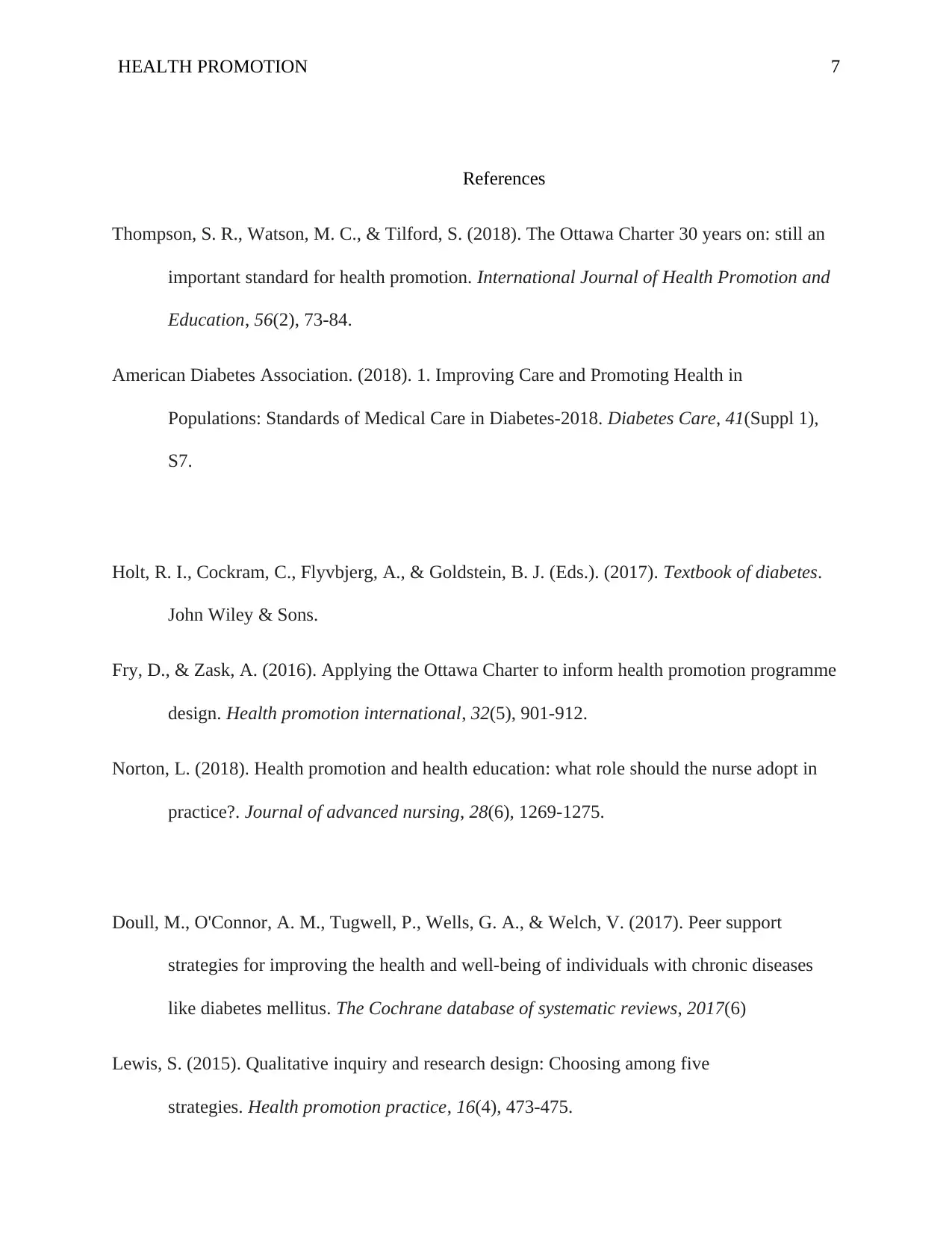
HEALTH PROMOTION 7
References
Thompson, S. R., Watson, M. C., & Tilford, S. (2018). The Ottawa Charter 30 years on: still an
important standard for health promotion. International Journal of Health Promotion and
Education, 56(2), 73-84.
American Diabetes Association. (2018). 1. Improving Care and Promoting Health in
Populations: Standards of Medical Care in Diabetes-2018. Diabetes Care, 41(Suppl 1),
S7.
Holt, R. I., Cockram, C., Flyvbjerg, A., & Goldstein, B. J. (Eds.). (2017). Textbook of diabetes.
John Wiley & Sons.
Fry, D., & Zask, A. (2016). Applying the Ottawa Charter to inform health promotion programme
design. Health promotion international, 32(5), 901-912.
Norton, L. (2018). Health promotion and health education: what role should the nurse adopt in
practice?. Journal of advanced nursing, 28(6), 1269-1275.
Doull, M., O'Connor, A. M., Tugwell, P., Wells, G. A., & Welch, V. (2017). Peer support
strategies for improving the health and well‐being of individuals with chronic diseases
like diabetes mellitus. The Cochrane database of systematic reviews, 2017(6)
Lewis, S. (2015). Qualitative inquiry and research design: Choosing among five
strategies. Health promotion practice, 16(4), 473-475.
References
Thompson, S. R., Watson, M. C., & Tilford, S. (2018). The Ottawa Charter 30 years on: still an
important standard for health promotion. International Journal of Health Promotion and
Education, 56(2), 73-84.
American Diabetes Association. (2018). 1. Improving Care and Promoting Health in
Populations: Standards of Medical Care in Diabetes-2018. Diabetes Care, 41(Suppl 1),
S7.
Holt, R. I., Cockram, C., Flyvbjerg, A., & Goldstein, B. J. (Eds.). (2017). Textbook of diabetes.
John Wiley & Sons.
Fry, D., & Zask, A. (2016). Applying the Ottawa Charter to inform health promotion programme
design. Health promotion international, 32(5), 901-912.
Norton, L. (2018). Health promotion and health education: what role should the nurse adopt in
practice?. Journal of advanced nursing, 28(6), 1269-1275.
Doull, M., O'Connor, A. M., Tugwell, P., Wells, G. A., & Welch, V. (2017). Peer support
strategies for improving the health and well‐being of individuals with chronic diseases
like diabetes mellitus. The Cochrane database of systematic reviews, 2017(6)
Lewis, S. (2015). Qualitative inquiry and research design: Choosing among five
strategies. Health promotion practice, 16(4), 473-475.
Paraphrase This Document
Need a fresh take? Get an instant paraphrase of this document with our AI Paraphraser
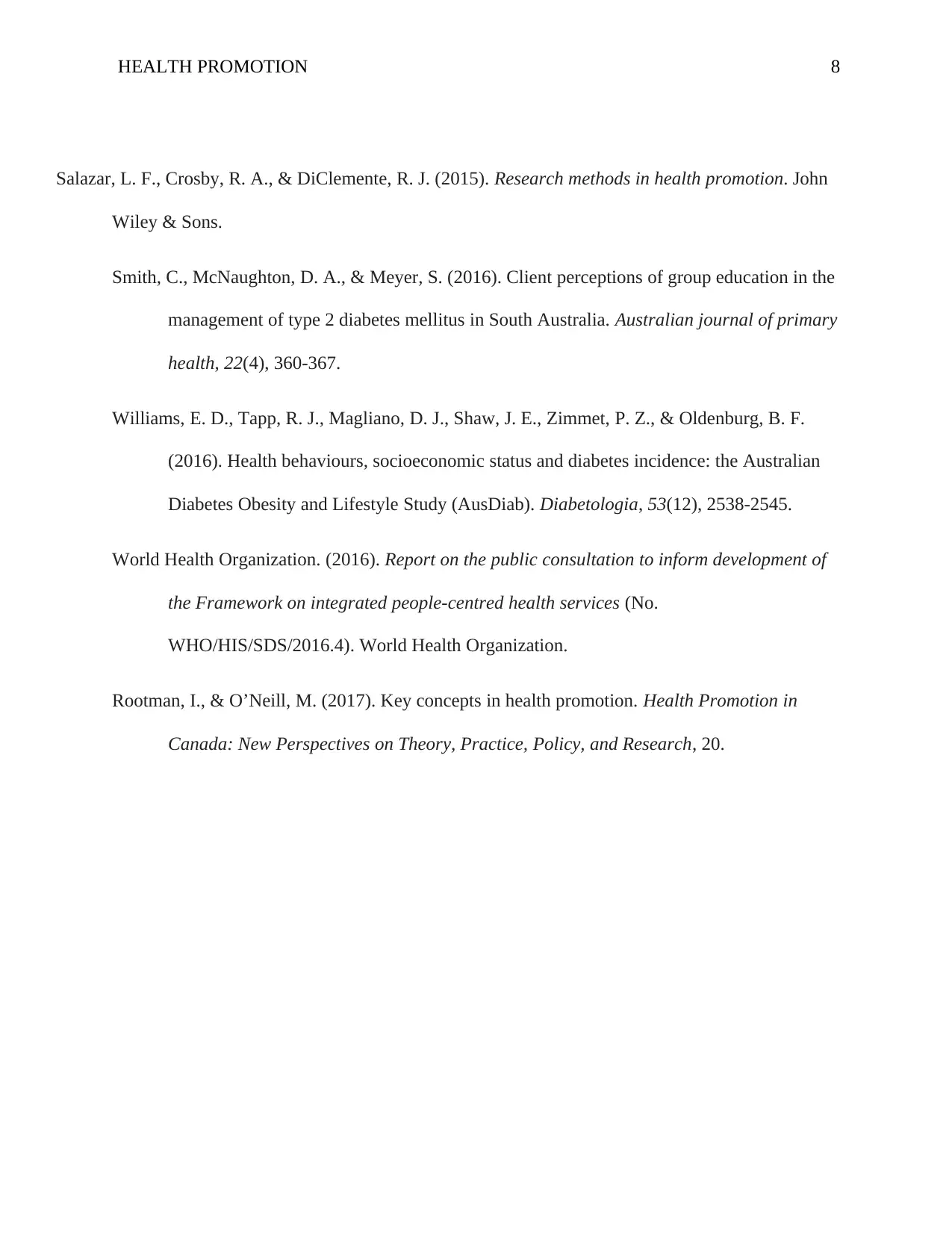
HEALTH PROMOTION 8
Salazar, L. F., Crosby, R. A., & DiClemente, R. J. (2015). Research methods in health promotion. John
Wiley & Sons.
Smith, C., McNaughton, D. A., & Meyer, S. (2016). Client perceptions of group education in the
management of type 2 diabetes mellitus in South Australia. Australian journal of primary
health, 22(4), 360-367.
Williams, E. D., Tapp, R. J., Magliano, D. J., Shaw, J. E., Zimmet, P. Z., & Oldenburg, B. F.
(2016). Health behaviours, socioeconomic status and diabetes incidence: the Australian
Diabetes Obesity and Lifestyle Study (AusDiab). Diabetologia, 53(12), 2538-2545.
World Health Organization. (2016). Report on the public consultation to inform development of
the Framework on integrated people-centred health services (No.
WHO/HIS/SDS/2016.4). World Health Organization.
Rootman, I., & O’Neill, M. (2017). Key concepts in health promotion. Health Promotion in
Canada: New Perspectives on Theory, Practice, Policy, and Research, 20.
Salazar, L. F., Crosby, R. A., & DiClemente, R. J. (2015). Research methods in health promotion. John
Wiley & Sons.
Smith, C., McNaughton, D. A., & Meyer, S. (2016). Client perceptions of group education in the
management of type 2 diabetes mellitus in South Australia. Australian journal of primary
health, 22(4), 360-367.
Williams, E. D., Tapp, R. J., Magliano, D. J., Shaw, J. E., Zimmet, P. Z., & Oldenburg, B. F.
(2016). Health behaviours, socioeconomic status and diabetes incidence: the Australian
Diabetes Obesity and Lifestyle Study (AusDiab). Diabetologia, 53(12), 2538-2545.
World Health Organization. (2016). Report on the public consultation to inform development of
the Framework on integrated people-centred health services (No.
WHO/HIS/SDS/2016.4). World Health Organization.
Rootman, I., & O’Neill, M. (2017). Key concepts in health promotion. Health Promotion in
Canada: New Perspectives on Theory, Practice, Policy, and Research, 20.
1 out of 8
Related Documents
Your All-in-One AI-Powered Toolkit for Academic Success.
+13062052269
info@desklib.com
Available 24*7 on WhatsApp / Email
![[object Object]](/_next/static/media/star-bottom.7253800d.svg)
Unlock your academic potential
Copyright © 2020–2025 A2Z Services. All Rights Reserved. Developed and managed by ZUCOL.





